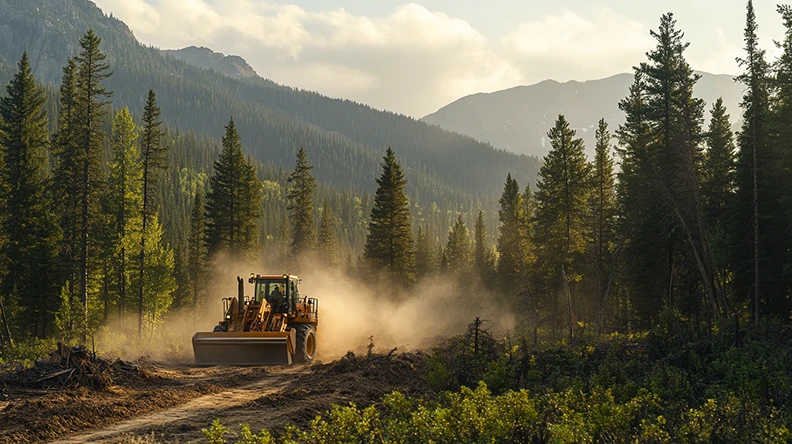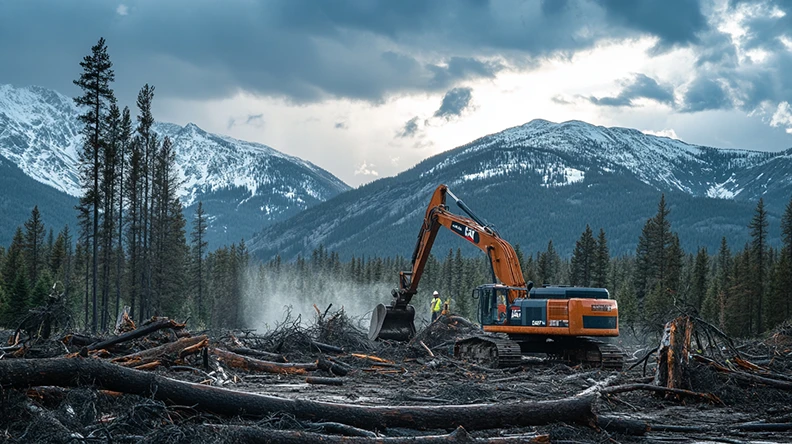Northern Montana is no stranger to extreme weather. From fierce winter storms and heavy snowfall to powerful winds and occasional flooding, properties in this region are regularly exposed to the elements. Severe weather strikes can leave your land cluttered with debris, damaged trees, and structural hazards. Storm damage cleanup becomes essential to restore your property and ensure its safety and usability.
Common Types of Storm Damage in Northern Montana
1. Wind Damage
Montana’s open plains and valleys are highly susceptible to strong winds, which can topple trees, snap branches, and scatter debris across your property. Windstorms can also damage roofs, fences, and outbuildings, creating safety hazards and increasing the risk of further structural damage.
2. Snow and Ice Accumulation
Heavy snowfall and ice storms are common during Montana’s harsh winters. Accumulated snow and ice can cause tree limbs to break, damage power lines, and compromise the structural integrity of roofs and other structures.
3. Flooding and Water Damage
Rapid snowmelt and heavy rains can lead to localized flooding. Flooding erodes soil, damages foundations, and leaves behind mud and debris. Poor drainage can exacerbate these issues, making cleanup even more challenging.
4. Hailstorms
Hail is another frequent concern in northern Montana, capable of causing significant damage to vehicles, roofs, windows, and landscaping. In some cases, hailstorms can also strip leaves from trees, leaving a mess of organic debris.
Steps for Effective Storm Damage Cleanup
Once the storm or weather event has passed, the time has come to figure out the cleanup.
Step 1: Assess the Damage
The first step in storm cleanup is a thorough assessment of the damage. Walk your property carefully to identify fallen trees, broken branches, structural damage, and areas with standing water or erosion. Take note of potential hazards such as dangling tree limbs or unstable structures.
In northern Montana, where storms can cause widespread damage, it’s important to prioritize safety during this initial assessment. Avoid approaching power lines or large debris until professionals have deemed the area safe.
Step 2: Clear Debris
Once the property is safe, begin clearing debris such as fallen branches, leaves, and scattered materials. Forestry mulching or brush hogging can be particularly useful for efficiently handling large volumes of organic debris. These methods not only clear the area but also recycle the material into mulch, which can be used to improve soil health.
Step 3: Remove Damaged Trees and Branches
Trees and branches damaged during storms can pose significant risks if not addressed promptly. Dead or weakened trees are more likely to fall during future storms, endangering people and property. Professional tree removal or trimming services ensure that these hazards are handled safely and effectively.
Step 4: Address Erosion and Drainage Issues
Flooding and water runoff can cause severe soil erosion, particularly in northern Montana’s sloped or hilly areas. Addressing these issues involves reshaping the land, installing drainage systems, or applying erosion control measures such as silt fencing or mulch.
Step 5: Repair Structures
Storms often leave behind damaged structures, from broken fences to dented roofs. Prompt repairs prevent further deterioration and help restore the property’s functionality. Depending on the extent of the damage, this step may require coordination with contractors or insurance providers.
Step 6: Restore Your Landscape
Once the immediate hazards are addressed, focus on restoring your property’s aesthetic appeal. Replanting damaged areas, spreading mulch, and reseeding grass can help bring your land back to life while preventing further erosion or soil degradation.
Benefits of Professional Storm Damage Cleanup
Storm damage cleanup can be overwhelming, particularly when dealing with large properties or extensive damage. Hiring professionals like BDH Land Solutions offers several advantages:
- Safety and Expertise: Professionals have the training and equipment needed to handle hazardous situations, such as removing unstable trees or clearing debris near power lines.
- Efficiency: With specialized tools and experience, professionals can complete the cleanup process much faster than attempting it on your own.
- Comprehensive Services: From debris removal to erosion control, professional cleanup services cover all aspects of storm recovery, ensuring your property is fully restored.
- Environmental Considerations: Services like forestry mulching repurpose storm debris into mulch, reducing waste and promoting sustainable land management.
- Peace of Mind: Partnering with a trusted team allows you to focus on other priorities while knowing your property is in capable hands.
Why Choose BDH Land Solutions for Storm Damage Cleanup?
At BDH Land Solutions, we understand the challenges that come with recovering from severe weather in northern Montana. Our storm damage cleanup services are tailored to the unique needs of the region, combining efficiency with a commitment to safety and sustainability.
Our experienced team handles everything from clearing debris to addressing erosion and drainage issues, ensuring that your property is restored to its best condition. Using state-of-the-art equipment and proven techniques, we work quickly and effectively to minimize disruption and get your property back on track.
You Deserve Land You Can Enjoy
Storm damage can leave your property in disarray, but with the right approach, recovery is possible. By understanding the steps involved in cleanup and partnering with professionals, you can restore your land while ensuring its safety and long-term health.
If your property has been impacted by a storm, contact BDH Land Solutions today. Let us help you navigate the cleanup process and bring your land back to life with our expert services. Together, we’ll weather the storm and create a brighter future for your property.





